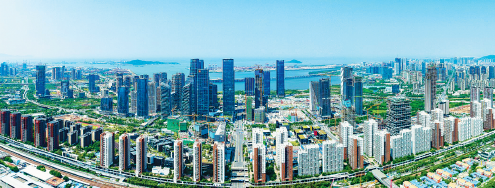Qianhai takes leading role in deepened reform
Experimental zone in west Shenzhen has completed more than 700 institutional innovations so far, which have inspired others to follow
Qianhai, an experimental zone in west Shenzhen that aims to strengthen collaboration between the city and neighboring Hong Kong, is to lead the Guangdong-Hong Kong-Macao Greater Bay Area in deepening reform and innovation.
The Qianhai Shenzhen-Hong Kong Modern Service Industry Cooperation Zone was approved by the State Council in August 2010.
Set in tidal-flat areas and land reclaimed from the sea, the zone in Guangdong province has carried out a package of experimental activities in fields including Shenzhen-Hong Kong collaboration, investment and trade assistance and the opening-up of the service industry.
Its role as a reformer was strengthened in a new plan, released by the State Council in September 2021, to comprehensively deepen reform and opening-up.
According to the Qianhai authority, it has accumulatively rolled out 725 achievements in institutional innovation so far, of which 72 have been followed and practiced by provinces outside Guangdong.
In October, seven innovative practices and related experiences of the comprehensive reform pilot work in Qianhai were highlighted by the National Development and Reform Commission in a report.
They cover fields such as intellectual property protection, legal services, talent management and healthcare.
Pilot measures
Qianhai is making breakthroughs in setting up a world-leading system to protect IP rights by using big data technology, introducing the role of technical investigators to solve problems in IP cases and implementing punitive damages over IP infringements.
In terms of talent management, Qianhai has built an international talent port and established an international talent services station to assist foreign scientists, scientific leading talents, entrepreneurs and highly-skilled talents with their border entry and accommodation issues.
The authority has mapped out an occupation list of foreign talents to meet the needs of companies in Qianhai.
Meanwhile, several government departments in Shenzhen have removed barriers to allow international talent into the zone. One of the measures is to relax occupation restrictions for Hong Kong and Macao professionals.
For example, Hong Kong construction professionals in 11 categories, including planners, architects, engineers and surveyors, can work in Qianhai after registration with the local authorities.
At the same time, tax professionals from Hong Kong and Macao no longer need to pass job qualification tests or have at least 180 days of working in tax and accounting firms before working in Qianhai.
As of the end of September, a total of 51 professional institutions and 482 professionals had registered in Qianhai, including 69 people from Hong Kong and Macao.
The Shenzhen Court of International Arbitration has explored a cooperation system for cross-border arbitration and introduced mediation to solve disputes.
The court has signed agreements with several international organizations and renowned arbitration institutes to carry out arbitration cooperation. It also set up a Guangdong-Hong Kong-Macao arbitration alliance with more than 10 representative institutions in the Bay Area to work out dispute resolution rules and a list of mediators.
So far, the arbitrator list of the court covers 114 countries and regions, including 567 foreign arbitrators.
In September, the first internationally certified hospital accreditation standard was released in Qianhai. It is the first of its kind on the Chinese mainland, which paves a way for domestic hospitals to comply with international standards.
Robust growth
The open and innovative governance of the Qianhai authority has stimulated strong economic growth in the zone. Its GDP surged 10.5 percent year-on-year to hit 175.6 billion yuan ($24.3 billion) in 2021, according to the Qianhai authority.
During the same period, the paid-in foreign investment grew roughly 15 percent year-on-year to $5.8 billion while imports and exports rose 20.3 percent to 1.74 trillion yuan.
The trend continued into 2022.In the first half of this year, Qianhai's GDP reached 82.11 billion yuan, up 2.6 percent year-on-year. The paid-in foreign capital in the zone climbed 17.4 percent year-on-year to $3.53 billion in the period.
Yu Tianlong, deputy general manager of Kerry Properties (Shenzhen), said Qianhai is increasingly attractive to investors with its incentive policies in deepening reform and opening-up, Shenzhen Special Zone Daily reported.
A group of companies have moved into their new offices in Qianhai, which were put into operation at the end of 2020. They include several leading corporations, industrial leaders and high-growth enterprises in the sectors of technology, finance, design and commercial services such as Siemens, IBM, MUFG Bank, Hang Seng Qianhai Fund Management and Immotor.
Qianhai will strengthen cooperation with Hong Kong and deepen reform and opening-up in line with the central government's requirement to serve the mainland and embrace the world, according to the authority.

A panoramic view of Qianhai, an experimental zone in Shenzhen, Guangdong province. FENG XIAO/FOR CHINA DAILY








